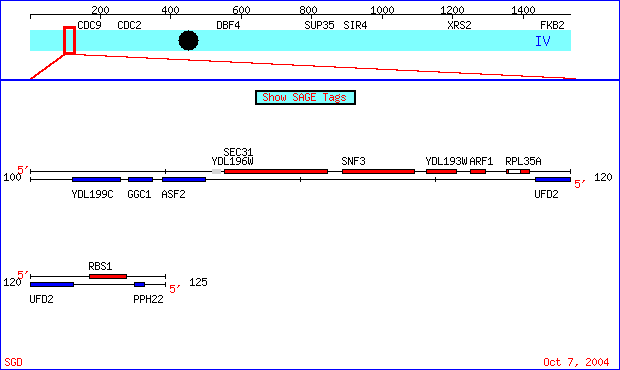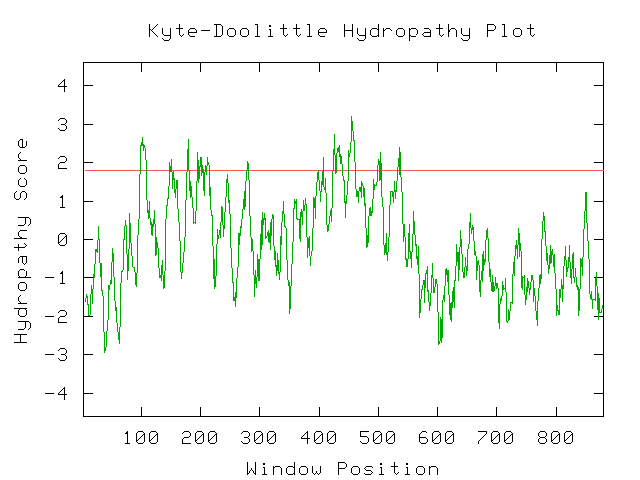
The annotated gene SNF3, or YDL194W, is found on the fourth chromosome of Saccharomyces cerevisiae. SNF3 encodes for a glucose sensor protein in the sugar and other transported region of the plasma membrane. It's function involves glucose binding, glucose transporter and receptor activity (Dolinski 2004).
This annotated gene is found in a small region of the fourth chromosome between 101581 and 124235 bp.

Figure 1. Chromosome location of the genes SNF3 and YDL199C. This figure shows that the location of the SNF3 and the YDL199C genes is on the fourth chromosome of the Saccharomyces cerevisiae (Cherry 1997). Image from <http://db.yeastgenome.org/cgi-bin/ORFMAP/ORFmap?dbid=S000002353 > Permission granted by SGD.
The protein, whose amino acid sequence can be found here, encoded for by the SNF3 gene is located in the plasma membrane and is composed of 12 transmembrane domains and an unusually long C-terminus tail (Özcan 1999). The Kyte-Doolittle Hydropathy Plot shows that there are many transmembrane domains located in the protein sequence between about 100 and 300 amino acids and between 400-550 amino acids in the window position.

Figure 2. Kyte-Doolittle Hydropathy Plot of SNF3. This Kyte-Doolittle Hydropathy Plot shows that sections of amino acids of the SNF3 protein are very likely transmembrane domains due to the peaks above 1.8 on this window size parameter scale of 11 (Kyte-Doolittle 2004). Image located at <http://occawlonline.pearsoned.com/bookbind/pubbooks/bc_mcampbell_genomics_1/medialib/activities/kd/kyte-doolittle.htm> Permission granted by A.M. Campbell.
The protein encoded by SNF3 is a glucose sensor that senses for low concentrations of extracellular glucose. It has been suggested that the proteins act as glucose receptors and are modified when attached to extracellular glucose, but additional functions may not depend on extracellular glucose (Dlugai 2001).
The biological process of SNF3 is the signal transduction of glucose, which affects the transport of sugar, and is involved in the transcriptional induction by glucose of genes that encode glucose transporters. It has been proven that this signal transfer is able to be completed in the absence of extracellular glucose (Dlugai 2001).

Figure 3. Conserved Domain search for the SFN3 gene. This figure shows the found putative conserved domain in the region of sugar and other transport (Sugar_tr) as well as in the region of carbohydrate transport and metabolism (AraJ) (NCBI 2004). Image located at <http://www.ncbi.nlm.nih.gov/Structure/cdd/wrpsb.cgi?RID=1097200225-16757-114062210569.BLASTQ4>.
The nonannotated gene YDL199C is found on the fourth chromosome of Saccharomyces cerevisiae, in the same region as the SNF3 gene, as indicated by Figure 1. The exact molecular function, biological process, and cellular component are unknown.
YDL199C is a hypothetical open reading frame which encodes a protein, whose amino acid sequence can be found here, likely to be found in the region of sugar and other transporters (NCBI 2004). The Kyte-Doolittle Hydropathy Plot (Figure 4) indicates the presence of transmembrane proteins located in the YDL199C gene sequence between about 130 and 550 in the window position. This shows that the probable cellular location of this protein is in the plasma membrane.

Figure 4. Kyte-Doolittle hydropathy Plot of YDL199C. This figure indicates a high likelihood of transmembrane domains located throughout this protein, based on the peaks above 1.8 on the windows parameter scale of 11 (Kyte-Doolittle 2004). Image located at <http://occawlonline.pearsoned.com/bookbind/pubbooks/bc_mcampbell_genomics_1/medialib/activities/kd/kyte-doolittle.htm> Permission granted by A.M. Campbell.
The biological function and process of this protein likely involves the signal transduction of glucose, affecting the transport of sugars, permeases of the major facilitator family, including transport and metabolism of carbohydrates, amino acids, and inorganic ions. More specifically in the carbohydrate transport and metabolism, this protein likely affects the sodium ion/melibiose symporter and other transporters. The functions are inferred from the presence of conserved domains in the regions of these functions (Figure 5).

Figure 5. Conserved Domain search of the YDL199C gene. This figure shows the presence of conserved domains in the regions of sugar transport (Sugar_tr), permeases (ProP), and melibiose symporter (MelB). Image located at <http://www.ncbi.nlm.nih.gov/Structure/cdd/wrpsb.cgi?RID=1097205051-10898-65243692284.BLASTQ4 >.
References
Cherry, JM., et al. Genetic and physical maps of Saccharomyces cerevisiae. Nature 1997 May 29; 387: 67-73.
Dolinski, K., et al. Saccharomyces Genome Database. <http://www.yeastgenome.org>. Accessed 2004 Oct 4.
Dlugai, Silke, et al. "Glucose-dependent and -independent signaling functions of the yeast glucose sensor Snf3". FEBS Letters. Volume 505. Issue 3. 2001 Sep 21. Pages 389-392. <http://www.sciencedirect.com/science/article/B6T36-4465JV6-B/2/83accfa630a0d0b57836f0e83f56c15c>. Accessed 2004 Oct 04.
Kye-Doolittle Hydopathy Plot. <http://occawlonline.pearsoned.com/bookbind/pubbooks/bc_mcampbell_genomics_1/medialib/activities/kd/kyte-doolittle.htm>. Accessed 2004 Oct 7.
[NCBI] National Center for Biological Technology. 2004 Sep 08. <http://www.ncbi.nlm.nih.gov/>. Accessed 2004 Oct 4.
Özcan, Sabire, et al. "Function and Regulation of Yeast Hexose Transporters." Microbiology and Molecular Biology Reviews. Vol. 63. No. 3. 1999 Sep. Pages 554-569. <http://mmbr.asm.org/cgi/content/full/63/3/554?view=full&pmid=10477308>. Accessed 2004 Oct 04.
Davidson College Biology Homepage
Davidson College Genomics Homepage
Email any questions or comments